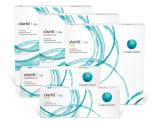
As a parent, you play a pivotal role in your child's well-being, and this extends to their eye health. Myopia, or nearsightedness, was once considered a common issue where distance vision is blurry, and it simply needed to be corrected by regular eyeglasses or contact lenses to see clearly. But myopia is now considered an epidemic1 and myopia management treatment is the standard of care in Canada.2 The good news is that with your active involvement, you can make a significant difference in protecting your child’s vision from getting worse as they grow.
In this article, we’ll explore the essential role parents play in learning how to manage myopia progression to protect your child’s vision from worsening, including lifestyle changes, consistent assessment, adoption of treatments, and how CooperVision® supports parents in this journey.
The vital role of parents
Parents are nearly the single most crucial factor in managing their child's eye health. Your support, awareness, and collaboration with Eye Care Professionals are key to achieving the best outcomes. Here's how you, as a parent, can actively contribute to your child's myopia management with some lifestyle changes—changes that may help your child’s overall health and eye health.
Outdoor time
Encourage your child to spend more time outdoors. Research indicates outdoor activities have been associated with a reduced risk of myopia.3
The benefits of natural light and the diverse visual stimuli of the outdoors can play a crucial role in managing myopia by giving the eyes a break from close-up tasks, such as reading and screen use.3 Encouraging outdoor play and exploration supports eye health and contributes to your child's overall well-being and physical development.
Limit screen time
It's essential to set reasonable limits on your child's screen time, particularly when it comes to digital devices. Adhering to the "20-20-20" rule can be an effective strategy.4 This rule recommends that every twenty minutes your child takes a twenty-second break to focus on something located at least twenty feet away.
This practice may reduce eye strain and discomfort associated with prolonged screen use.4 By monitoring and managing screen time, you help safeguard your child's visual health while promoting healthy screen habits.
Proper lighting
Ensuring your child has proper lighting when reading or studying is vital for their eye health. Good lighting reduces eye strain and supports comfortable and efficient reading and learning.5 Adequate lighting minimizes glare and shadows, enhancing the clarity of text and materials. Creating a well-lit environment can contribute to your child's vision, comfort, and productivity, making their reading and study sessions more enjoyable and effective.5
Healthy diet
A well-balanced diet rich in essential nutrients like vitamin C and omega-3 fatty acids significantly supports eye health.6 Encourage your child to incorporate foods, such as fatty fish (salmon, mackerel), leafy greens (spinach, kale), and fruits like kiwi and berries, into their meals.6
These foods are rich in vitamins and antioxidants that promote overall eye health.6 Omega-3 fatty acids, in particular, are known for their positive effects on vision.6 A nutritious diet benefits your child's eyes and their overall growth and well-being.
Consistent assessment
Regular eye exams are critical for managing myopia. Schedule routine eye check-ups for your child with an optometrist. Early detection and monitoring of myopia progression are essential to implementing effective management strategies. Optometrists can assess your child's eye health, determine the rate of myopia progression, and recommend suitable myopia control* treatments.
Adoption of treatments
In some cases, optometrists may recommend myopia control* and management treatments to slow down the progression of myopia in children. These treatments may include specialty spectacle lenses (i.e. eyeglasses), soft contact lenses, ortho-k and eye drops.7
Following your optometrist's guidance regarding the recommended myopia treatment plan for your child is essential. Consistency is key to achieving the best results, and your active participation ensures your child receives the necessary care.
How CooperVision® supports you
CooperVision® is committed to providing effective solutions for myopia management. MiSight® 1 day contact lenses are specially designed to slow myopia progression in age-appropriate children.8† Here's how CooperVision® complements your efforts.
MiSight® 1 day contact lenses
MiSight® 1 day contact lenses are a proven option for myopia control.8* They offer the convenience of daily disposable contact lenses, making them safe,9 child-friend and easy to use option for age-appropriate children.8 Though you may be anxious about getting your child to use a myopia control* contact lens, many young children happily use contact lenses to avoid wearing glasses.10±
MiSight® 1 day myopia control* soft contact lenses are designed to reduce the rate of worsening myopia and are dual-purpose, providing clear vision while helping reduce the risk of complications associated with high myopia.8,11 By working closely with optometrists and considering treatments like MiSight® 1 day contact lenses, you can effectively manage your child's myopia and ensure their eye health remains a top priority.
Parents making a difference
As a parent, you have a crucial role to play in managing your child's myopia. Implementing lifestyle changes, ensuring regular eye assessments, and following recommended treatments are key steps in reducing the rate of worsening myopia.
The commitment CooperVision® makes to myopia control* and management and the availability of products like MiSight® 1 day contact lenses can be helpful in your efforts to protect your child's vision from getting worse as they grow.
Remember, your proactive involvement can significantly impact your child's eye health and overall well-being. By building a supportive environment and working closely with optometrists, you can ensure your child's myopia is managed effectively, providing them with a brighter future. Contact CooperVision® to find a qualified eye-care professional today.
*U.S. Indications for Use: MiSight® 1 day (omafilcon A) soft (hydrophilic) contact lenses for daily wear are indicated for the correction of myopic ametropia and for slowing the progression of myopia in children with non-diseased eyes, who at the initiation of treatment are 8-12 years of age and have a refraction of -0.75 to -4.00 diopters (spherical equivalent) with ≤ 0.75 diopters of astigmatism. The lens is to be discarded after each removal. Canadian Indications for Use: MiSight (omafilcon A) Soft Contact Lenses for Myopia Control may reduce the rate of myopia progression in children (6-18) and correct ametropia. Reduction of myopia progression was observed in children with wearing time of 12 hours (8-16 hours) per day, 6.4 days (5-7) per week in a clinical study. Permanent myopia control after lens treatment is discontinued is not supported by clinical studies. MiSight (omafilcon A) Soft Contact Lenses for Myopia Control are indicated for single use daily disposable wear. When prescribed for daily disposable wear, the lens is to be discarded after each removal.
† Compared to a single vision lens over a 3 year period.
± 95% - 100% of children expressed a preference for contact lenses over glasses at each visit over 36 months
Sources
- https://www.aao.org/eyenet/article/facing-the-myopia-epidemic
- https://opto.ca/document/cao-position-statement-myopia-management
- https://www.myopiaprofile.com/articles/how-outdoor-time-influences-myopia-prevention-and-control-a-meta-analysis#:~:text=Spending%20time%20outdoors%20was%20found,both%20myopes%20and%20non%2Dmyopes
- https://www.allaboutvision.com/conditions/refractive-errors/what-is-20-20-20-rule/
- https://opto.ca/eye-health-library/why-proper-lighting-important-while-reading
- https://optom.on.ca/nutritionmonthblog/
- https://www.mykidsvision.org/knowledge-centre/which-is-the-best-option-for-myopia-control
- Chamberlain, P. et al. A 3-year Randomized Clinical Trial of MiSight Lenses for Myopia Control. Optometry and Vision Science 96(8):p 556-567.
- Woods J, et al. Ocular health of children wearing daily disposable contact lenses over a 6-year period. CLAE 2021 Aug;44(4):101391.
- Sulley A et al. Wearer experience and subjective responses with dual focus compared to spherical, single vision soft contact lenses in children during a 3-year clinical trial. AAO 2019 Poster Presentation.
- Tideman JW et al. Association of axial length with risk of uncorrectable visual impairment for Europeans with myopia. JAMA Ophthalmol. 2016;134:1355-1363.






